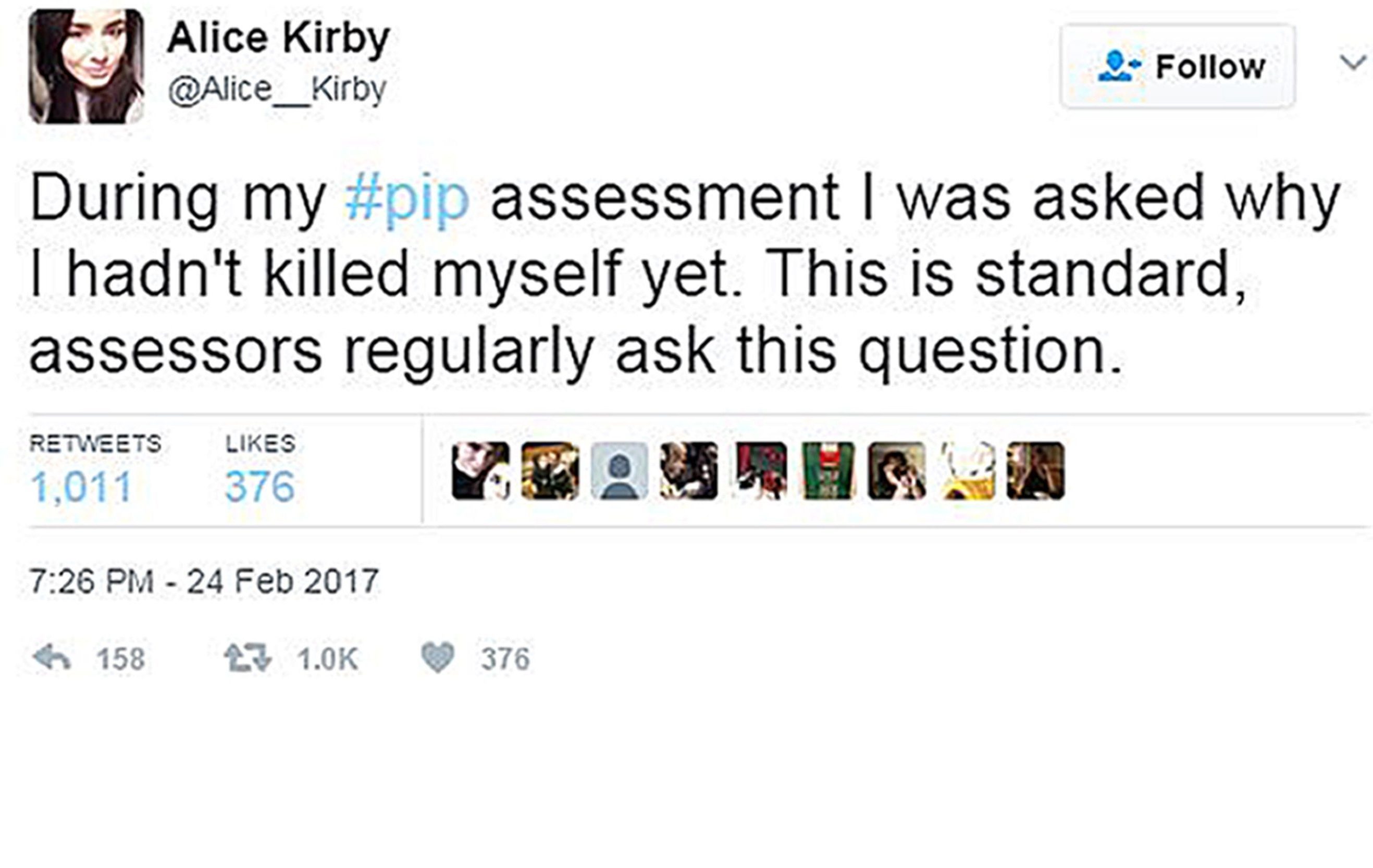
A woman with mental health problems claims she was asked why she had not killed herself as part of her assessment for disability benefits.
Alice Kirby, who also has physical disabilities, accused the Department for Work and Pensions (DWP) of “institutional abuse” as she spoke about her experience of personal independence payments (PIP).
She told the Press Association: “Phrased appropriately and sensitively, questions about suicide and asking a person why they haven’t killed themselves could be appropriate in a psychiatric assessment, but it should not be discussed in a benefits assessment.
“In this setting it’s not safe to ask questions like these because assessors have neither the time or skills to support us, and there’s no consideration of the impact it could have on our mental health.
“The questions were also completely unnecessary, they were barely mentioned in my report and had no impact on my award.”
Since tweeting about her experience, Ms Kirby, from Sheffield, said she had been shocked at how many people said they had been asked similar questions.
She added: “Some people told me that when they answered saying they felt suicidal or had attempted suicide, assessors said things such as ‘that’s understandable’.
“There was someone else who was asked to detail exactly how they would carry out suicide if they were to kill themselves.”
Another person was asked why his attempts at suicide had failed, Ms Kirby said.
The DWP insists that all staff carrying out PIP assessments receive training on mental health conditions, including issues around suicidal thoughts, which have to be explored further given their duty of care to claimants.
A spokeswoman said: “Supporting people with mental health conditions is a priority for this Government and that’s why we’re spending a record amount on mental health support, over £11 billion a year.
“There are now more people with mental health conditions receiving the higher rates of both PIP components than the previous disability living allowance (DLA) equivalents.
“All PIP assessors receive training on mental health conditions, so they are able to explore claimants’ circumstances carefully and sensitively.”
Private companies Capita and Atos are not provided with a set of specific questions to follow in PIP assessments, though the DWP insists such sensitive questions are asked appropriately.
A spokesman for Atos, which carried out Ms Kirby’s assessment, said: “The professional and compassionate service we provide to claimants is our primary consideration.
“The specific question is inappropriate and if asked would not meet the high standards and training in place which enable the sensitive and appropriate handling of assessments by our professional assessors for those with mental health conditions.”
Ms Kirby, 25, was originally awarded the higher rate for both parts of PIP, and underwent an early reassessment in November after telling the DWP that her health had deteriorated.
Despite feeling that her conditions have worsened, she has been taken down to the standard rate.
“I’ve read both of my reports, and it’s very clear that I’m sicker in the most recent assessment compared to the first, but I was still cut,” said Ms Kirby.
“It makes me feel like I’m almost irrelevant. My disabilities and limitations don’t seem to really matter in this whole process.
“The DWP have an agenda, they have targets to meet, and if my assessor had a target to cut someone down that week then she was going to meet that, despite my symptoms.”
Ms Kirby accused assessors of being “inconsistent and often they actually just outright lie” in their reports.
She is awaiting the result of a mandatory reconsideration, but expects to have to go to tribunal to try to get the DWP’s decision overruled.
She added: “I would describe this process and what I have been through as institutional abuse, and I’m not alone.
“It may be carried out by an institution rather than an individual, but it’s still abuse
“And it’s almost faceless because it’s being perpetrated by this huge institution, a department of government, but the impact on us is still the same.”

Enjoy the convenience of having The Sunday Post delivered as a digital ePaper straight to your smartphone, tablet or computer.
Subscribe for only £5.49 a month and enjoy all the benefits of the printed paper as a digital replica.
Subscribe